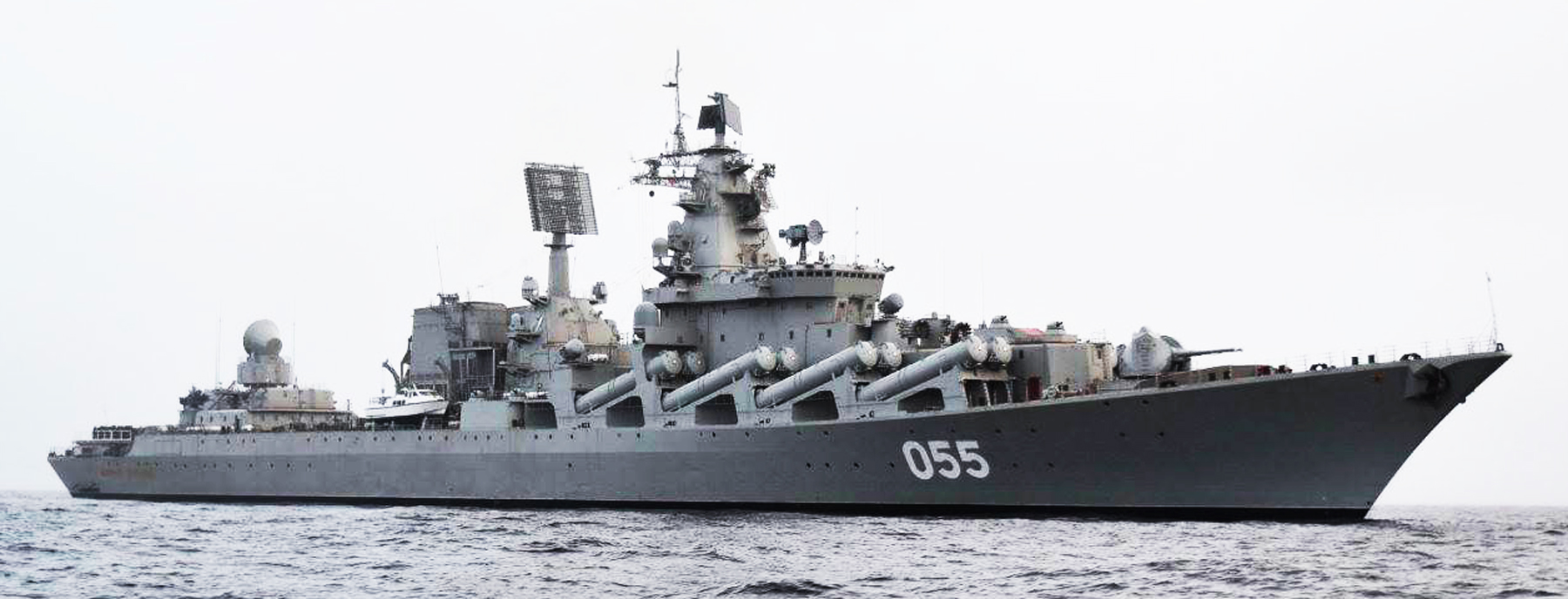
 3(10) cruisers – Atlant-class, Project 1164 (1972-today):
3(10) cruisers – Atlant-class, Project 1164 (1972-today):
Moskva (ex-Slava), Marshal Ustinov, Varyag (ex-Chervona Ukraina), Ukraina (ex-Komsomolets, ex-Admiral Flota Lobov), Oktyabrskaya Revolutsiya (Cancelled, BU), Admiral Gorshkov, Varyag, Sevastopol, one more (all planned, cancelled)
The Slava-class missile cruisers (Project 1164, for early NATO Black Com-2, then Krasina) were anti-ship units scheduled to the four Kynda, reaching their age limit. From past experience, they were much larger at 12,500 tons vs 5,600 for the former, had their cruise missiles in fixed and independent ramps and brand new SS-N-12 bazalt (Sandbox), supersonic (mach 2.5) shared also to the four Kiev. Six were planned, but onl four completed, including two before the fall of the USSR. The ex-Russian, Ex-Ukrainian Slava and Russian again “Moskva” made healines when sunk by Ukrainian antiship missiles during the war in Ukraine on 14 april 2022. The other ships are listed as an “active status” as of 2023.
Genesis of the class
Development specifics
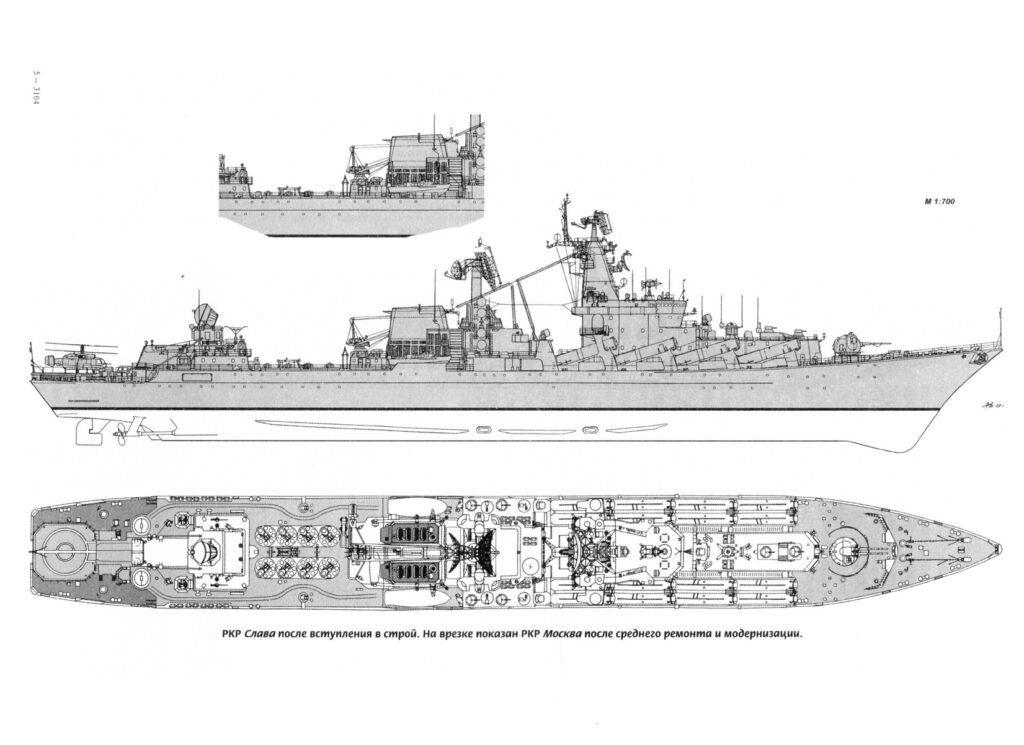
Based on the planned replacement of the Kynda class in the mid-1970s, the TTZ charged of writing down specifications for the technical project of 1972, were:
-Providing combat capabilities in the fleet in remote areas of the seas and oceans (so more range)
-The destruction of enemy surface ships, including aircraft carriers.
Later, the following tasks were added to the Project 1164 cruisers, striking large surface ships and enemy strike groups, solving the tasks of collective air defense of the formations and convoys in distant seas and combating submarines, supporting landings and shelling the coast occupied by the enemy. The Project development history officially started on April 20, 1972, when the decision of the Commission under the Council of Ministers of the USSR No. 87 was adopted. The draft design 1164 “Atlant” was issued to the Northern Design Bureau in October 1972. The director of the Northern Design Bureau A.K. Perkov and after 1979 – Mutikhin, Valentin Ivanovich, was appointed chief designer. The chief observer from the Navy was captain 2nd rank A.N. Blinov. At first they went to the conclusion of a 10,000 tons cruisers armed with Bazalt missile launcher, and eight octuple S-300F air defense systems in VLS, plus two Osa point air defense systems, two 100-mm AK-100 guns, two quintuple TTs, ZAK close-defense AK-630 CIWS. In December 1972, preliminary design was ready. The technical project was approved on August 21, 1974.

Project 1293
The laying of lead ship “Slava” (serial number 2008) took place on October 4, 1976 at 61 Communards Shipyard, Mykolaiv yard (Black sea). The Atlant-class cruisers first appeared in 1983, and were supposed to control the world’s oceans areas vital for the security of the USSR: North Atlantic, Black Sea, Mediterranean and read sea, Arctic, Pacific and in the event of receiving an appropriate order, they were poids to launch “saturation” strikes on strike aircraft carrier groups of the Navy US and NATO. For their their sixteen P-500 Bazalt cruise missiles with optional 1kt nuclear warheads were instrumental and they became the most powerful ships in their class precisely because of these missiles, between their speed, powerful warhead and 1000 km range. It was estimated 1-2 were sufficient to knock out an aircraft carrier, by default of sinking her. Some estimated they would be sitting ducks for Soviet SSNs and SSGNs after this.
More in depth: The full development
Back to the early 1970s OKB-52, under V.N. Chelomey, was preparing a new fleet ship, called provisionally the “Kyrgyz Republic” 2nd generation. This “new” generation was grown in an extensive way: The P-6 missile was taken as a basis, to which improvements were made such as a more economical engine installed, firing range and flight speed increased, on-board digital computer to select the optimal attack option in a jamming environment and onboard active jamming station, on increased dimensions. Chelomey affirmed confidently this surpassed any potential enemy. Some idea of new 4K80 missile, P-500 complex, later receiving the name “Basalt” in service, weas ahead 20-25 years of the “Regulus I” and “Regulus II”.
During one of his visits to the Northern Design Bureau at the end of 1971, S.G. Gorshkov suggested to the designers the following:
“work on the option of replacing eight 85R RPK-3 Metel anti-submarine missiles with eight 4K80 PKPK P-500 missiles on Project 1134B ships”
The Commander-in-Chief, was about to violate the mass construction of Project 1134B, starting from the 7th ship and it was nowhere near a “cosmetic operation” as expected, which was to put him at odds with the General Staff, still pushing the wheels spokes of mass fleet construction, with politic complication in inter-service rivalries down the line.
Viktor Danilovich Rubtsov was chief designer of the project proposal, “ancestor” of Project 1164, Valentin Ivanovich Mutikhin, also chief designer of Projects 1164 and 11641. V.I. Mutikhin was then 40 years old. Nice reconstruction on sakhalia.net
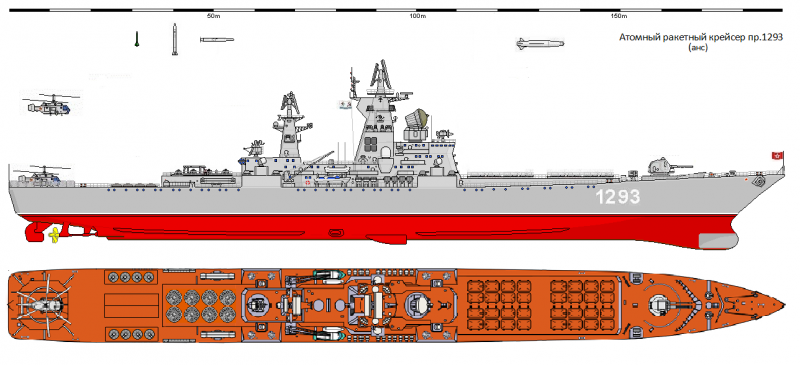
Project 1144 cruisers turned out to be large and expensive and in the 1970s, admirals, designers, and shipbuilders wanted to make the same concept ships smaller and cheaper already at early construction stage of the Kirov. Project 1293 was born, closely related to project 1165, assigned to the Northern Design Bureau under B.I. Kupensky (projects 50, 61, 1144) as chief designer. The result was slightly larger than Project 1164 (Kara), but smaller the Kirovs. At first it was to have a nuclear power plant to escort a new nuclear aircraft carrier prepared at Nikolaev.
This was as for estimates, still a 14,000 tons, 190 x 21 m ships, armed with 16 “Granit” VLS system and “Fal” SAM (improved “Fort”) with 64 missiles, “Dagger”, two “Vodopad”, two RBU-12000, a twin 130-AU AK-130 and four AK-630M CIWS and not the too large 30-mm Kortik as well as a large hangar for two Ka-27 helicopters.

Project 1199 and 11990, the “universal cruiser”.
To unify hull and power plant a multirole “universal cruiser” was developed as Project 1199 “Anchar”, unified with Project 1193. The nuclear power plant was dropped and three SAM “Uragan” were to be instaled as well a 130-mm twin gun, eight “Moskit” SAM; just one Ka-27, two RBU-6000 and gas turbine for Project 1199 and with the Fal air defense missile system, Vodopad, Moskit, Kinzhal.
The nuclear-powered Project 1293 was dropped and led to the unified Project 11990 a bit smaller (188 x 19 m, 10,000 tons). It eveolved again to 4 Uragan, 6 Kinzhal, 4 Kortik, Vodopad.
Later in place of Kinzhal VLS, space was free to later instal the Onyx in developement and RKPTZ-1 “Udav” ASWRL.
By the end of the 1980s, steel was cut at Nikolaev for the lead ship of projet 11990, still unnamed, until work stopped as the yard was already busy with Project 1164 ships. V.D. Rubtsov the developed a twelve anti-ship missiles ships with the the new P-500 and the “universal cruiser” was abandoned, leading to the Slava class.
S.G. Gorshkov told to V.N. Chelomey during development:
“Whatever you want, Vladimir Nikolaevich, but the rocket is longer and heavier than the P-6. I won’t accept it from you anymore, even with super-performance characteristics!”
This put the project at odds with representatives of the Soviet militaro-industrial complex just like in the USA, bit in USSR it was more an Industrial-military complex in the post-Stalin period.
Generally successful developments of the design bureau led to the publication of a decision by the Commission under the Council of Ministers on “military-industrial issues No. 87”, dated April 20, 1972, to begin development of technical specifications (TTZ) for the new missile cruiser Project 1164 (code “Atlant”). The fleet under S.G. Gorshkov managed to legitimize the birth of a new ship, and not a simple modification of the previous project as pushed by the central committe for reasons of mass and cost. Looking ahead, Project 1164 had almost nothing in common with Project 1134B (Kara class), despite some continuity remains.
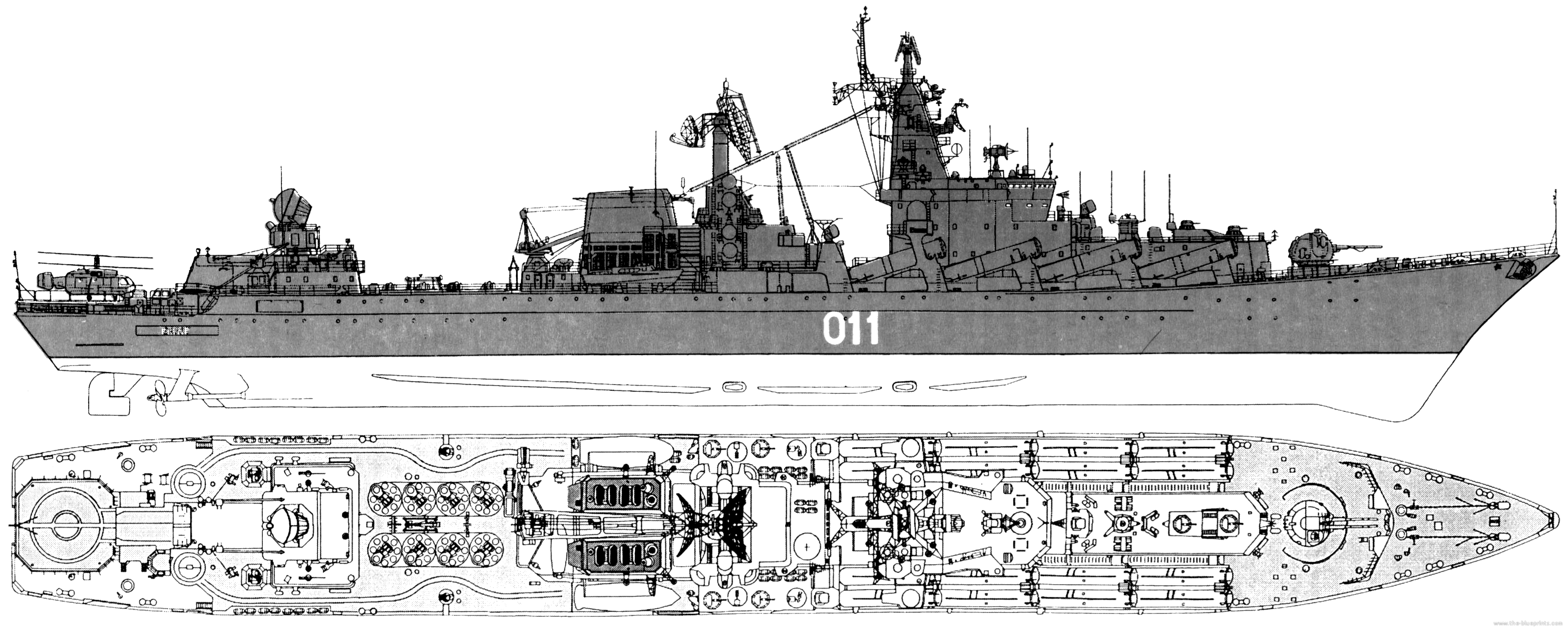
Varyag, ex-Chervonia Ukrainia
Main tasks of the ship formulated in the TTZ were:
-Improving combat stability to naval forces in remote oceanic areas
-Destruction of enemy surface ships, including aircraft carriers
Later Alexander Kueiich Perkov was appointed chief designer of the project but remained purely nominal as he had not designed a single commissioned ship as chief designer before and more was burdened with directorial concerns and according to his colleagues did not like the new cruiser, but he was soon sent into retirement. Thus, main concerns for the design fell as before on V.I. Mutikhin, chief designer of the project for good.
The Navy appointed a senior researcher at the Central Research Institute, captain 2nd rank, A.N. Blinova. He worked smoothly well with Mutikhin as well as Captain 2nd Rank V.G. Basov, who replaced Blinov later. Chief Observers of the Navy were Rear Admiral B.A. Kolyzaev and Captain 1st Rank A.A. Borisova. Also participated the Central Research Institute A.N. Krylov, Northern Design Bureau and central board of the Navy. More there, to be translated.
Final acception
The “Atlant class cruisers” which first appeared in 1983 were supposed to control oceanic areas of interest considered vital for the security of the USSR, such as, for example, the North Atlantic, and if given the order, had to fire first of all a massive missile strike against the Navy’s strike aircraft carrier groups of USA and NATO. The main armament of cruisers this is really centered, as were the Kyndas before, on the 16 P-500 “Basalt” cruise missiles, and the provision of nuclear warheads remained classified to this day. During modernization of Project 1164, vessels these missiles were replaced by the P-1000 “Vulcan”.
These ships are one of the most powerful assets of today’s Russian Navy, still, precisely because of these missiles, with large range, great speed and powerful warhead. They were tailored to destroy an aircraft carrier with one or two hits. In total, it was planned to build 10 cruisers until program was reduced to 6 ships and eventually 4, with only 3 were commissioned, for at least the three main fleets as the USSR collapsed.
Design of the class
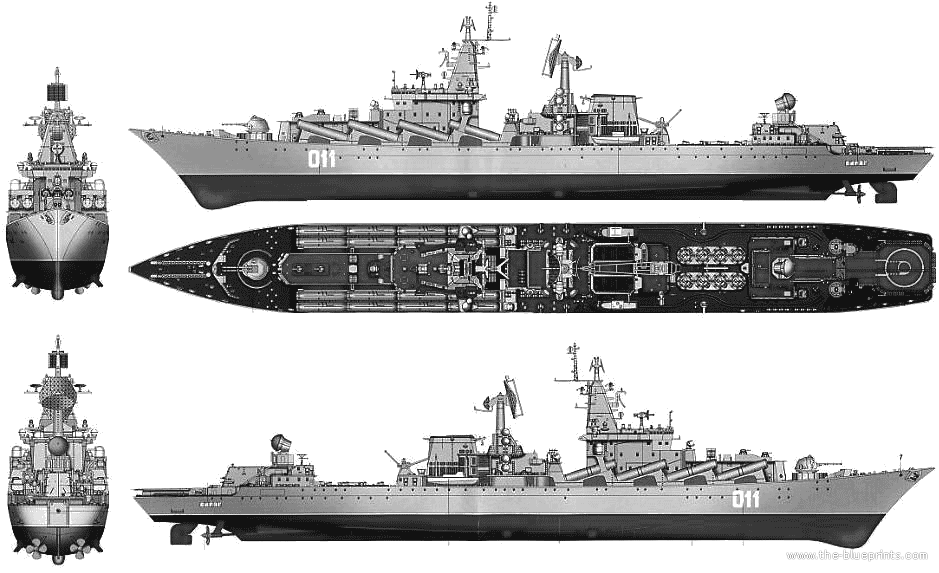
These were no doubt large and impressive ships in the line of the Kiev and Kirovs typical of the onceanic ambitions of the late 1970s:
With 9,380 tons standard and 11,490 tons full load, they had wide and parallelepipedic near-flush deck hulls, with a quite important flare at the prow, one deck tall. The hull was broken aft to the ASW equipped poop. The hull measured 186.4 m (611 ft 7 in) long for 20.8 m (68 ft 3 in) so 1/9 ratio and very important draught of 8.4 m (27 ft 7 in). They had an important crew, circa 600 and later reduced thanks to automation, with facilities to be used as flagships. The ship had no armour to speak of by the CiC and some ammo area were apparently protected by splinter-proof plating. Such modern ship is dependent of its electronic warfare panoply to deal with incoming missiles.
Hull and general design
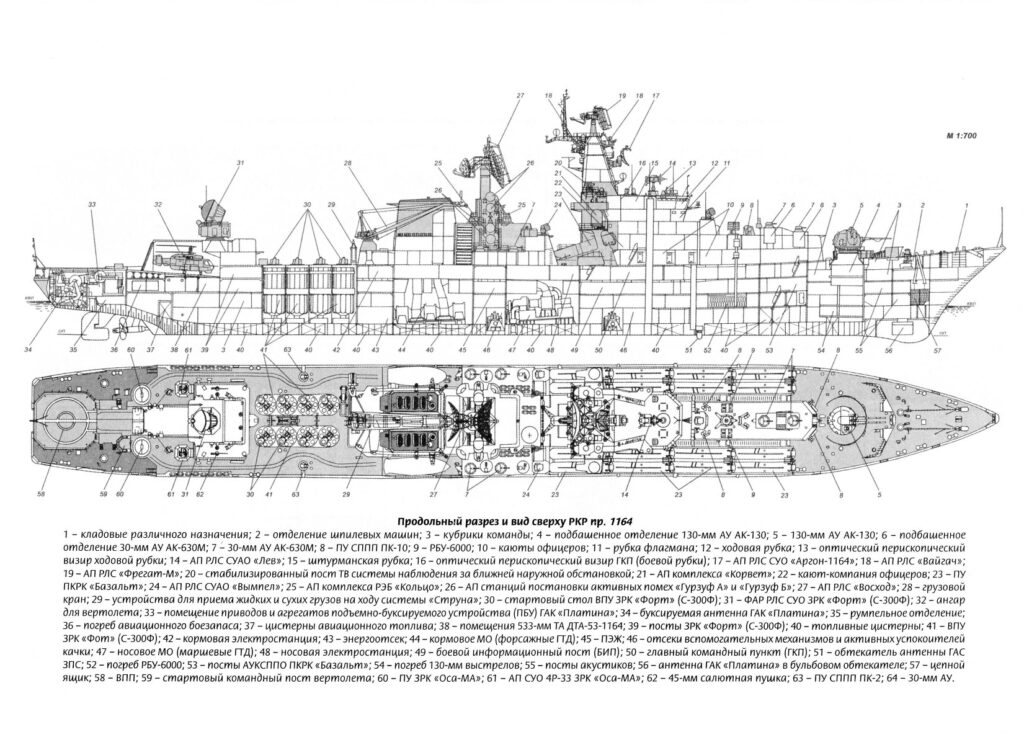
Hull and superstructure design:
By design, both had a long forecastle, a well developed three-island superstructure, tower-like pyramidal foremasts and mainmasts. For better seaworthiness and stability, frames have a strong camber, and the stem is strongly inclined.
-In the first compartment along the forward collision bulkhead, there are auxiliary rooms and storerooms.
-In the second compartment below the waterline is house the GAS “Platina” sonar room and above it the chain storage well, storerooms and capstan.
-The third compartment occupies the turret compartment and AK-130 ammunitrion storage room, ventilation rooms and combat posts.
-The 4th compartment is reserved for personnel rooms and living spaces, equipment rooms in the hold.
-The 5th compartment, in addition to living quarters, hosts an ammunition storage room for the RBU-6000 Smerch-2.
-The 6th compartment houses the combat information center (CiC), connected to the conning tower by a one-man elevator. There are also auxiliary systems and drives for the bow pair of pitch stabilizers.
-The 8th compartment contains the bow engine room with M-21 propulsion turbines, gearbox and heat recovery system, auxiliary steam turbines on common frame.
-The 9th compartment contains auxiliary systems and a second pair of anti-roll bars, and then the aft engine room with M-8KF afterburning turbines.
-The 10th compartment contains auxiliary systems
-The 12th compartment contains under-deck conveyor belt and ammunition holds for the Fort air defense system and its revolving vertical launchers as well as those for the PK-2 jamming system, and utility freight elevator.
-The 13th and 14th compartments houses main crew quarters, auxiliary and service rooms, torpedo tubes, and around 300-310 frames ammunition stores for the Osa-M missiles.
-The aft compartment accommodates the towed antenna sonar and associated systems and lifting gear.
Throughout the entire length of the ship, there is a double bottom under fuel tanks to avoid spills in emergency situations. The main ammunition stores are located throughout the ship, separated by thick bulkheads (classified armour) with sprinklers and automatic fire extinguishing systems with detection and instant foam spread/flash flooding valves. All these measures structurally ensures survivability in case of flooding for at least three adjacent compartments except for the engine rooms. This was of course all theoertical given what we know about Moskva (see below).
To maintain stability from the start, lightweight structures were constructed with aluminum alloys above the weather deck, of the AMG type, along with steel which provides internal strenght. The above-deck superstructures in areas exposed to flames (from missile launches) are made of steel. The upper structures, far from flames danger, are made of aluminum alloys. On the lower tiers of the bridge forward, there is a flagship command post and cabins for senior officers, and wardroom. The superstructure blocks have tailored cuts to prevent damage due to bending stresses. The funnel with air intake systems are located across the ship to allow redundancy.
There is a special equipment close to the funnels, a crane with a lifting capacity of 8.5 tons installed behind them to lift utility service boats and is normally kept in a stowed position between them and secured.
In the aft part of the main deck, the separate island is mostly occupied by a generous helicopter hangar, crowned by the 3P41 “Volna” antenna, tracking and illuminating targets for the anti-aircraft missile system “Fort”. The above stern deck is occupied by an helipad with take-off and landing support systems. In addition to rescue equipment sets, there is a command boat (Project 1404) and work boat Project 1402 served by the crane and on davits.
A crew’s delight
The crew ranged from 485, including 66 officers, 64 midshipmen and 355 sailors on Slava to 476 (62 officers) on subsequent ships. The residential block of the officers’ quarters is beautifully finished with plenty of space thanks to the roomy superstucture. Saloons are decorated with inlaid wood paneling, paintings and carpeting. Sailors accustomed to standard ship saunas are amazed by the comfortable swimming pool with waterfall, healing showers, extensive steam room, and carved dressing room. On such cruisers, a simple sauna served as wellness center on these long voyages. The outpatient clinic is also well equipped. There is also a “microclimate” in all premises using four BM-600 refrigeration units. There is both an air cleaner and heat balance regulator, air conditioning throughout with slight overpressure if needed in NBC conditions as the ships could be completely sealed.
Powerplant
Since the Kara class, the Slava ships adopted a COGOG powerplant with a set of four GTU M21 mated on two M70 cruise gas turbines plus 4 × M90 boost gas turbines, two cruise steam turbines, two exhaust gas boilers,four M8KF gas turbines on two shafts and a total output of 130,000 shp (97,000 kW). This was enough for 32 knots (59 km/h; 37 mph) and a range of 6,800 nmi (12,600 km; 7,800 mi) at 18 knots (33 km/h; 21 mph).
More in detail, the main engines are two combined automated M-21 units, third generation, including two cruising economical reversible turbines M-70 with 10,000 hp each, four afterburning accelerating turbines (also reversible) of the M-8KF type with 22,500 hp each and two permanently operating TUK steam turbines of 1,500 hp each. When all sources of hot exhaust gas are turned on, their power increases to 2500 hp. Thus, maximum continuous power is 113,000 hp (115,000 hp).
The ship’s top speed reported was 32.5 knots mix maximum economical cruising range of more than 8,000 miles.
The main turbines are located in the bow engine room, with two-stage damping and driving shafts through two-speed gearboxes. Afterburner turbines in the aft engine room are installed on single-stage damping and connected to the shaft with soundproof couplings through mating single-speed gearboxes that provide 300 revolutions to the propellers. The power plant is controlled from a central control room using a cable system.
The cruiser uses a heat recovery circuit in which gases used in turbines at temperatures up to 400 degrees go into a specially designed steam boiler. The water in it turns into steam, which in turn is overheated and goes both to domestic needs and to turbines, which “help” rotate the propellers, thus increasing the overall efficiency of the power plant by 20%, at 18 knots by 12%, and At the same time, they reduce the temperature of the exhaust gases.
To generate electricity, three power plants with a total capacity of 8250 kW are used, in which there are two gas turbine generators with a capacity of 1500 and 1250 kW, producing three-phase alternating current of 380 volts (50 hertz). There is one emergency lighting diesel generator.
Armament
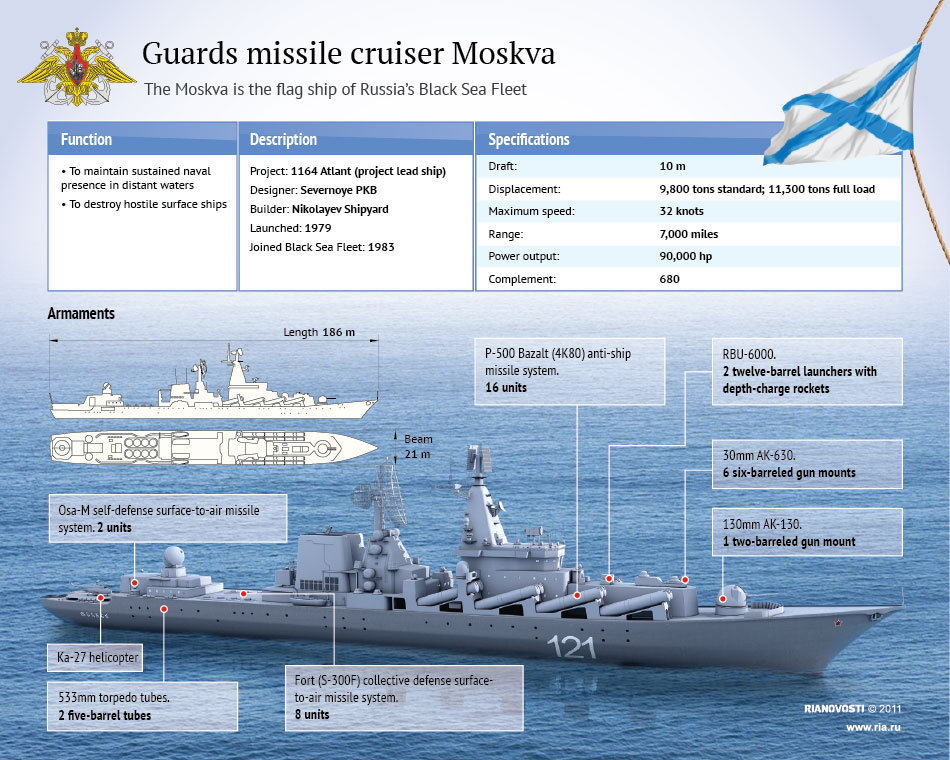
Infographic cia Ria novotsi 2011
Anti-ship: 16 launchers, Vulcan complex (P-1000 anti-ship missiles)
Anti-submarine: 2×5 torpedo tubes banks, 2 RBU-6000 rocket launchers, ship-based Ka-25RC helicopter.
Anti-Aircraft: 2×2 130 mm AK-130 (600 rounds) and six AK-630 CIWS (2000 rds per system), 2x Osa-MA air SAM (40 missiles), S-300F “Fort” SAM (64).
Antiship
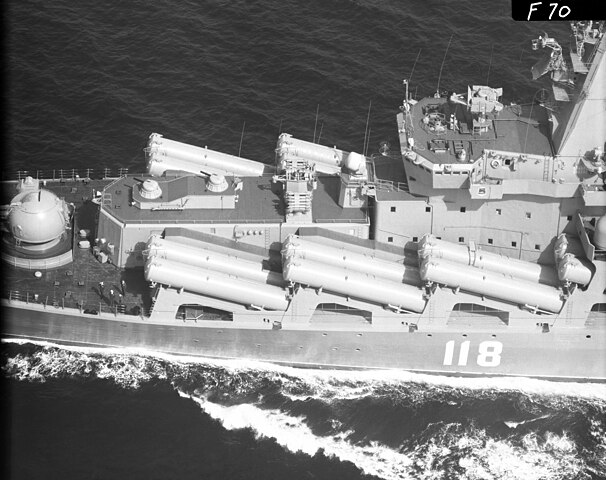
Greatest assets onboard, 16 (four paired ramps either side) with P-1000 Vulcan (SS-N-12 Sandbox) anti-ship missiles. They were genuinely feared by NATO for their range and payload, including a one ton nuclear warhead. Most EW countering warfare exercizes practiced by NATO were counting on 16 of these flying to a task group at any time without warning. No reloads, this was done in port.
P-1000 stats:
A missile weighing up to 6 tons and a flight speed of 3077 km/h is equipped with a powerful (500 kg) conventional high-explosive-cumulative or nuclear (350 kt) warhead and is capable hit designated targets at a range of up to 1000 km. The flight of the anti-ship missiles to the target is carried out along a complex trajectory. It is equipped with a telecontrol system and an onboard station for electronic countermeasures against air defense systems of the attacked ship. The length of the rocket is 11.7 m, the wingspan is 2.6 m, the diameter of the rocket is 0.88 m.
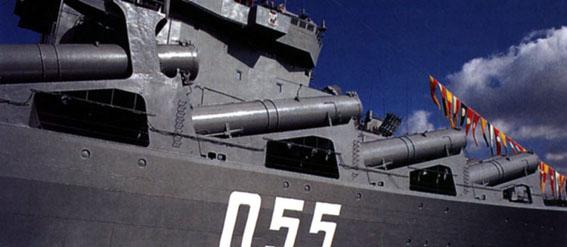

⚙ specifications P-500 or P-1000* |
|
| Weight | 4,800 kg (10,600 lb) |
| Dimensions | 11.7 x 0.88 wsp 2.6 meters |
| Propulsion | turbojet |
| Speed | Mach 3+* at 50–5,000 meters |
| Range | 550 km (300 nmi) (P-500) |
| Guidance | Semi-active radar homing, terminal active radar homing |
| Payload | HE 1,000 kg (2,205 lb) (P-500) or nuclear 350 kt |
Anti-Air
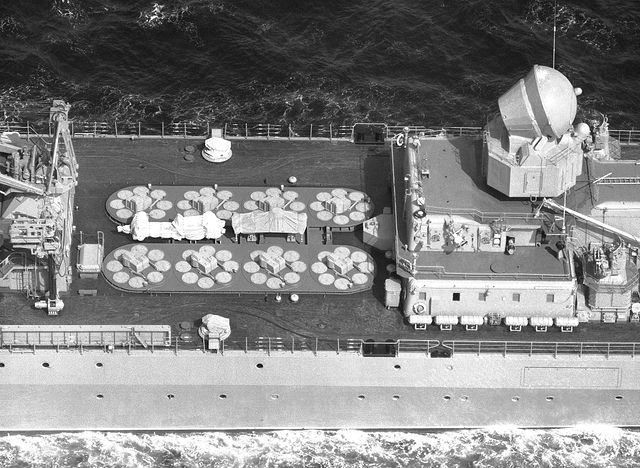
Missiles
-64 (8 × 8) S-300F Fort (SA-N-6 Grumble):
Long-range surface-to-air missiles. Short range assets designed for self-defense from close in air attacks by aircraft, helicopters and anti-ship missiles, as well as firing at surface targets. The combat capabilities of the air defense system make it possible to destroy air targets at speeds of up to 600 m/s at a range of up to 15 km and an altitude of up to 5 km. Specs: Length 3 m, weight 128 kg. Like the “Ushakov-class”, the long range S-300MPU Rif/”SA-N-6 “Grumble” surface to air missile system – on the “Moskva-class” the missiles are launched from 8 octuple b-303A VLS launchers amidships.
Upgraded S-300F Fort: 7–90 km (4.3–56 mi; 3.8–49 nmi) and maximum target speed up to Mach 4, while the engagement altitude was reduced to 25–25,000 m (82–82,021 ft). The naval version utilises the TOP SAIL or TOP STEER, TOP PAIR, and 3R41 Volna (TOP DOME) radars.
⚙ specifications SAN-6 Grumble |
|
| Weight | 128 kgs |
| Dimensions | 3 m long |
| Propulsion | Solid booster/Rocket |
| Speed | Mach 3 |
| Range | 15 km, alt. 5,000 m |
| Guidance | Ship guidance |
| Payload | HE warhead |
-40 (2 × 20) OSA-M (SA-N-4 Gecko):
The 64 missiles are installed in 8 revolver-type launchers below deck. Designed to protect from attacks by longer range aircraft, cruise ships missiles.
Specs: length 7.9 m, diameter 0.34 m, weight 1600 kg speed up to 2000 m/s, range up to 75 km and up to 25 km in altitude.
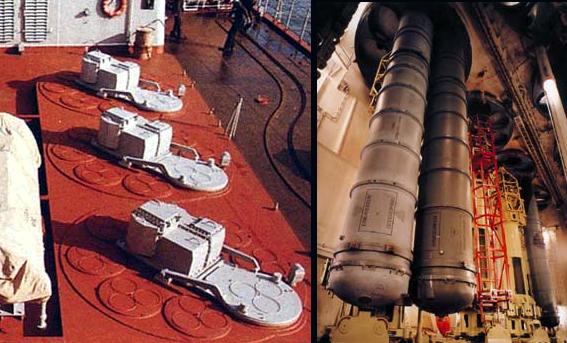
⚙ specifications SA-N-4 Gecko |
|
| Weight | 170 kg |
| Dimensions | 3,158 x 2,096 m wp |
| Propulsion | Solid propellant dual-thrust rocket motor, 2s boost, 15s sustain |
| Speed | 1020 m/s at 12,000 metres (39,000 ft) |
| Range | 15 kilometres (9.3 mi) |
| Guidance | RF CLOS, accuracy 5 m |
| Payload | 16 kg Frag-HE, Contact/proximity fuse |
Artillery
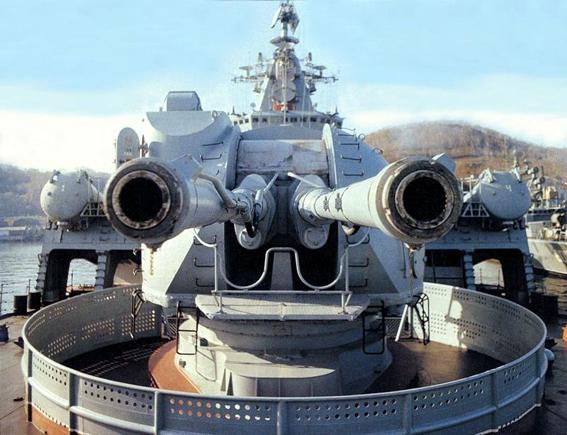
-Twin AK-130 130 mm/L70: Dual purpose guns forward, also usable against ground targets, and designed to fire at sea, air and coastal targets at a range of up to 24 km, with a rate of fire of 90 rounds/min. The weight of the installation reaches 98 tons, the weight of the shot is 86.2 kg, the weight of the projectile is 33.4 kg, the initial velocity of the projectile is 850 m/s. The AK-130 ammunition includes unitary cartridges with a high-explosive fragmentation projectile, equipped with three types of fuses.
-Six AK-630 CIWS: Close-in weapons systems, also capable of antiship missile fire. Ammunition capacity of 16,000 rounds, 2,000 rounds per belt) are designed to destroy air targets, anti-ship missiles, small ships, pop-up mines and lightly armored ground targets. The initial speed of a projectile with a diameter of 30 mm, weighing 0.39 kg reaches 900 m/s, rate of fire is 6000 rounds/min, range is up to 8 km.
Anti-Submarine Weapons
-2 × 12 RBU-6000 anti-submarine mortars:
Ammunition load of 96 rocket depth charges, bomb weight 110 kg, warhead weight 25 kg, length 1.8 m, caliber 212 mm. Rocket depth charges designed mainly to protect the ship from torpedoes and submarines, by conducting single or salvo fire, firing range 6 km, diving depth 500 m.
-10 (2×5) 533 mm torpedo tubes, heavy ASuW torpedoes:
533 mm (21 in), torpedo length 7 m, weight 2 tons, explosive charge 400 kg range up to 22 km, speed up to 55 knots (100 km/h). The torpedo tubes are compatible also with the following:
-Vodopad-NK anti-submarine system
-Kalibr-NK universal missile system.
Kamov Ka-25 or Kamov Ka-27 Helicopter:
Sensors
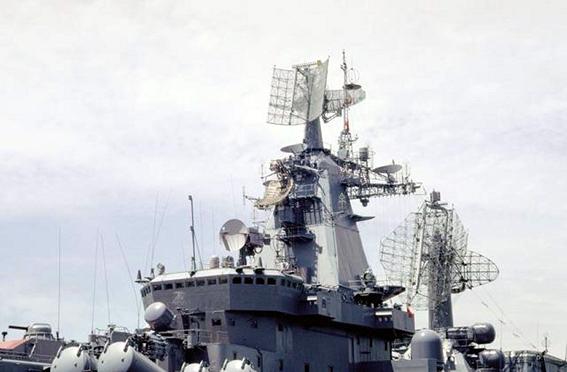
MR-800 Voshkod and MR-700 Fregat radar complex of the 1164 Atlant/”Moscow-class”(two first units)
Radars:
-MR-800 Voshkod/Top Pair 3-D long-range air search
-MR-700 Fregat/Top Steer (first two)
-MR-710 Fregat-MA/Top Plate 3-D air search (remainder)
Sonar:
-MG-332 Tigan-2T/Bull Nose hull mounted LF
-Platina/Horse Tail MF VDS
Fire Control:
-3R41 Volna/Top Dome SA-N-6 SAM control
-MPZ-301 Baza/Pop Group SA-N-4 SAM control
-Argument/Front Door-C SSM control
Electronic warfare
-Kol’cho suite with Gurzhor-A&B/Side Globe intercept
-MR-404/Rum Tub jammers
-Bell Crown intercept, Bell Push intercept
-2x PK-2 decoy RL
-12x PK-10 decoy RL (last two)

Author’s illustration of the Slava
⚙ specifications |
|
| Displacement | 10,000t, 12,500t FL |
| Dimensions | 187 x 20.8 x 7.5 m (611 ft 7 in x 68 ft 3 in x 27 ft 7 in) |
| Propulsion | 2 shafts, 4x CODOG turbines*, 125,000 hp. |
| Speed | 32 knots (59 km/h; 37 mph) |
| Range | 10,000 nmi (19,000 km; 12,000 mi) at 16 knots (30 km/h; 18 mph) |
| Armament | 16x SSN-12, 8×8 LM SAN-6 (64), 2x SAN-4 (40), 1×2 130mm gun, 2×5 533mm TTs, 6x 30mm CIWS, 2x ASW RBU 6000 ASWRL (144) |
| Electronics | Radar 2 Top Pair, Top Steer, 3 Palm Front, 1 Top Dome, 2 Pop Group, 1 Kite Screech, 1 Front Piece, 3 Bass Tilt. LF Sonar, 1 SPV, 8 CME Side Globes, 1 Satcom Punch Bowl. |
| Air group | 1 ASW helicopter Kamov Ka-25 Hormone-B |
| Crew | 600 (1990), 419+66 in 2022. |
Overall Assessment
In general, Project 1164 became an alternative to the overly expensive Project 1144 Orlan cruisers (Kirov class). With a more limited displacement, Slava (Project 1164) class cruisers had almost equivalent offensive capabilities and comparable defensive ones. According to modern classifications, the Russian Navy assimilates them as cruisers/large destroyers, such as Ticonderoga-class and Japanese Atago-class or King Sejong-class “destroyers” with similar displacement ir circa 9000-11000 tons.
However, priority in these cruisers was given to offensive rather than defensive characteristics (splendidly exposed with the sinking of Moskva), so they were also criticized. They had for example a reduced supply of S-300F missiles with 64, compared to 96 on the Kirov class, and so their weak point is their self-defense air defense, consisting of only two outdated Osa-M air defense systems. For comparison, the Kirovs have 16 Kinzhal launchers.
In addition, due to the presence of only one 3R41 Volna missile guidance radar, the Fort complex (SAN-6 Grumble) is only able to repel an attack from only one direction at a time, whereas the if 3R41 Volna radar fails, the ship’s long-range air defense is paralyzed. For comparison again, the Kirov class at least counts on two 3R41 radars, which allows them to repel attacks from several directions simultaneously and not risk losing their defense capability if one of these radar fails.
In general, the Slava class fully complied with the “late” doctrine of the Soviet Navy, massive use of surface missile carriers for strike functions covered by carrier-based aircraft.
Alone in a competitive environement, they are very much doomed by modern antiship missile attacks, as shown again, by the case of Moskva (see later).
The Slava class in service
Constructions, completions and cancellations
In total, the plan was ambitious and planned not four, but ten project 1164 cruisers, but the program was reduced to 6 units, enough for three oceans and provisions for ships in maintenance. In the end, only four were laid down and only three effectively commissioned. Construction of the last ships laid down was cancelled as USSR fell and was replaced by the Russian Federation, for budgetary reasons.
The Slava class in the end saw four ships operational, respectively in 1982, 86, 89 and 93. The first three were in service in 1990 at the time of the fall of the USSR. The other three, Admiral Lobov (started 1984, launched 1990 and planned for completion in 1993) was transferred to Ukraine and renamed Vilna Ukraina, but still lacked equipment to be operational. Ukraine then did not had any means to carry out this work. As a result, through a joint contract to sell Sovremenny-class destroyers to the Chinese, funds arrived and Ukraina was finally completed in 2001. Rossiya and Admiral Gorshkov were not even started and were soon removed from the lists. All were built in Nikolayev, on modified Kara plans.
The original names of the first three (renamed after 1990) were Slava, Marshal Ustinov and Chervonia Ukraina. Class (renamed): Moskva, Admiral Isakov, Admiral Ustinov, Varyag, Vilna Ukrayina.
They seem to be flagships in the Northern Fleet (Ustinov), and in Black Sea (Ukrayina, Moskva), and Baltic (Lobov). The Moskva (formerly Slava) was sent for modernization to Nikolayev in 1990 and remained there until 2000, as the funds for doing so were insufficient.
They were upgraded along the way: by the late 1980s already, Slava and Marshal Ustinov saw the removal of their Bazalt SSM and addition of eight twin Vulkan missile P-1000. The collapsed of the Sovit Union and lack of funds condemns the ship to have just machinery overhauls and a few other systems. As situation improved, it was planned a serie of upgrades. The first was Variag in 2007, Pacific Fleet, which saw the removal of two MR-123 Vympel-A radars and replacement for MR-123-02/3 Bagira radars. In 2013, Slava saw also the replacement of her forward MR-123 Vympel-A radar by a MR-123-02/3 Bagira and Slava in 2014 had the MR-231-3 radar added. By 2014, Marshal Ustinov in the nothern fleet obtained the MR-650 Podberiozovik-ET2 radar in replacement for her MR-600 Voskhod radar. 2017, Marshal Ustinov saw the replacement of her MR-710 Fregat-M radar and MGK-335 Platina sonar for the new MR-750 Fregat-M2 radar and Zaria-SK sonar.
 Moskva (ex-Slava)
Moskva (ex-Slava)
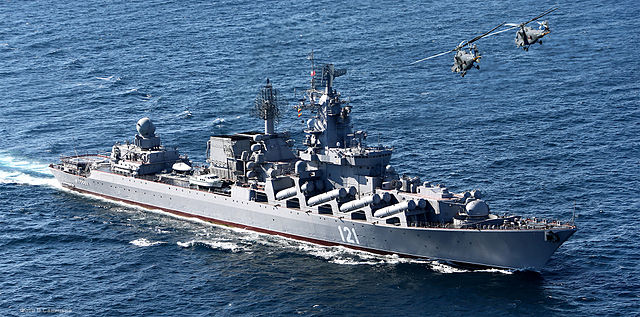
Laid down in 1976 in Shipyard 445, 61 Kommunara Shipbuilding Plant (Nykolaiv), she was launched in 1979, commissioned on 30 January 1983. Between 18 and 22 November 1986 she made her long shakedown cruise to Greece, visiting Piraeus. She escorted Soviet premier Mikhail Gorbachev to Malta Summit on 2–3 December 1989 with US President George H. W. Bush, close to her counterpart USS Belknap off Marsaxlokk. Stormy weather had it called in the press the “Seasick Summit”, the delegation later moving to the Maxim Gorkiy in Marsaxlokk Bay. She had a refit from December 1990 until late 1998 due to the fall of USSR. On 15 May 1995, she was formally renamed Moskva, after the former helicopter cruiser decommissioned, recom. herself in April 2000, and replacin the Kynda class Admiral Golovko as flagship, Russian Black Sea Fleet.
By early April 2003 escorted by the frigates frigate Pytlivyy, Smetlivy, and a landing ship, she departed Sevastopol for exercises in the Indian Ocean and the Soviet Pacific Fleet (task group Marshal Shaposhnikov/Admiral Panteleyev) and exercizes with the Indian Navy, support from the Project 1559V tanker Ivan Bubnov and Project 712 ocean-going tug Shakhter.
She visited Malta’s Grand Harbour in October 2004 and assisted to the Mediterranean Conference in Valletta. In 2008 and 2009 she toured the Mediterranean and took part in naval drills with the Northern Fleet. By August 2008, with the invasion of Georgia, she was patrolling the Black Sea and apparently fired at by the Georgian Navy. She was posted in the Abkhazian capital Sukhumi after the war ended.
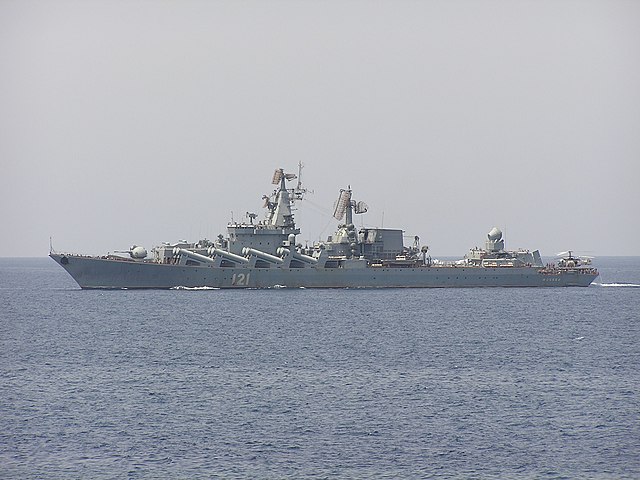
On 3 December 2009, she was drydocked in Sevastopol for an overhaul and by April 2010 was reported to join an exercize in the Indian Ocean to conduct exercises, by August 2013 she visited Havana, Cuba and by late August 2013, dispatched off the coast of Syria. From 2014 she blockaded the Ukrainian fleet in Donuzlav Lake. By July 2015 she visited Luanda, for a cooperation with Angola. By late September 2015 she was off the Syrian town of Latakia to support the air campaign in Syria. On 25 November 2015 she was sent close to the coastal Syria-Turkey border bu relieved by sister ship Varyag and was awarded the Order of Nakhimov for her service by 22 July 2016.
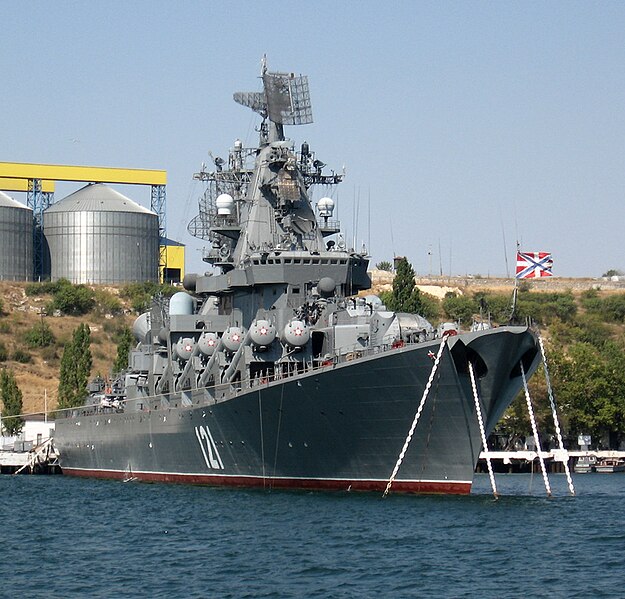
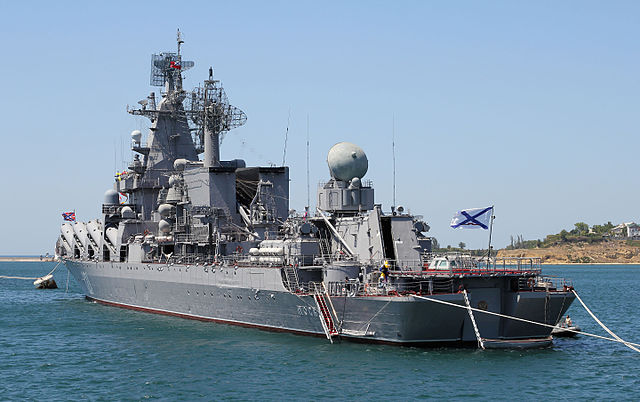
She was semi-inactivated for an overhaul never completely done between January 2016 and July 2018 and by June 2019, she left Sevastopol for a serie of trials. By July 2020, her full maintenance was at last complet to keep her in service until 2040. She was seen in exercises in March 2021, firing her new Vulkan anti-ship missiles in April 2021. With the invasion of Ukraine, as flagship of the Russian Black Sea Fleet, she covered the naval assault until her loss in April 2022 and was deployed for the attack on Snake Island with the patrol boat Vasily Bykov.
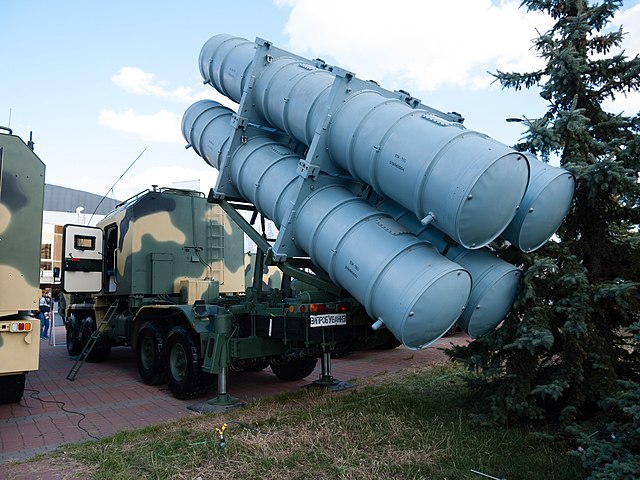
Ukrainian Neptun complex exposed in Kiev
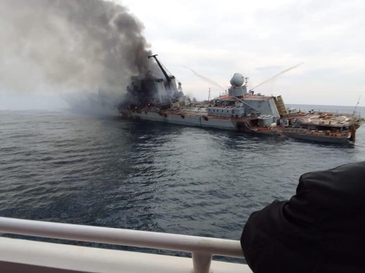 Famously asking the surrender by radio and being answered back something on the line of gen.McAuliffe’s at the siege of Bastogne. The small Ukrainian garrison was captured and the cruiser stayed behind other Russian warships, providing air cover off Odessa when late on 13 April 2022 the ship was reported by Ukrainian authorities “on fire”. Odessa governor Maksym Marchenko later announced she had been struck by two R-360 Neptune anti-ship missiles, 80 nautical miles south of the city around 19:00 local time. She sank before 03:00 on 14 April 2022. This is so far, the largest ship sunk in combat since the General Belgrano in April 1982, ironically exactly 40 years.
Famously asking the surrender by radio and being answered back something on the line of gen.McAuliffe’s at the siege of Bastogne. The small Ukrainian garrison was captured and the cruiser stayed behind other Russian warships, providing air cover off Odessa when late on 13 April 2022 the ship was reported by Ukrainian authorities “on fire”. Odessa governor Maksym Marchenko later announced she had been struck by two R-360 Neptune anti-ship missiles, 80 nautical miles south of the city around 19:00 local time. She sank before 03:00 on 14 April 2022. This is so far, the largest ship sunk in combat since the General Belgrano in April 1982, ironically exactly 40 years.
***UPDATE***
Beyond any reasonable doubt that the 11,490 ton SLAVA Class cruiser #Moskva has been hit off Ukraine
Even Russian sources report it
She had been operating in relatively predictable patterns in the Northern Black Sea
The close-in defenses on this ship were dated pic.twitter.com/5rmlg6IpKa
— H I Sutton (@CovertShores) April 14, 2022
 Marshal Ustinov (ex-Admiral Flota Lobov)
Marshal Ustinov (ex-Admiral Flota Lobov)
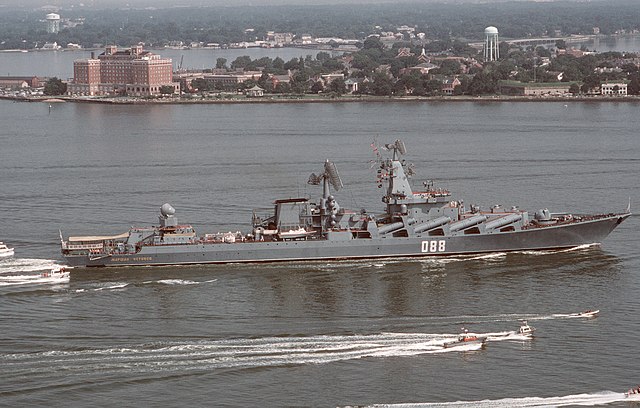
Marshal Ustinov is the second cruiser completed, in service with the Soviet Navy for this class. She was laid down at 61 Kommuna #445 Yard initially as “Admiral of the Fleet Lobov” in Mykolaiv on 5 October 1978. She was Launched on 25 February 1982, Commissioned on 19 September 1986, and homeported in Severomorsk, Northern Fleet. Renamed Dmitriy Ustinov, after the former Soviet Minister of Defence, she was assigned to the 43rd Missile Ship Division. By September 15, 1986 she entered service after full trials acceptance by the Naval staff. On November 5, 1986, she is renamed “Marshal Ustinov” sporting the Red Banner of the Northern Fleet.
From December 1987 to June 1988, she performs sorties in the Mediterranean Sea until relieved in 1989 and in July 21-29, 1989 made an official visit to Norfolk naval base in Virginia (USA), a first as the cold war was still running, and symbol of relations heating up under the Gorbatchev era. On July 16-20 1991 she made a second visit ti the US east coast, this time the Mayport naval base in Florida, with crews exchanges. On June 30 until July 5 1993 she made another western visit, this time to Halifax in Canada.
From 1994 to December 17, 1997, she underwent a major overhaul at St. Petersburg in Severnaya Verf, lasting for three years due to the lack of funds. During renovation, the main power plant was entirely overhauled and most components replaced. The main armament was also upgraded with the P-1000 Vulcan missiles, recuperating the P-500 Basalt launchers however, limiting the maximum firing range.
By May 1995 The ship, freshly renamed “Republic of Kazakhstan” is present as flagship at the naval parade in St. Petersburg for the 50th ww2 victory anniversary and By July 1996 again at the naval parade in St. Petersburg for the 300th anniversary of the Russian Fleet.
January 2001 saw her in ovherhaul at SRZ-35, JSC Zvezdochka. On February 21, 2001, the city of Minsk in Belarus, took patronage of the cruiser, and sent a delegation to visit the ship and it was secured by an agreement signed by Minsk City Executive Committee and ship’s commander. From then on, Belarus would pay for the ship’s maintenance and expenses.
From September 21 to October 22, 2004, the cruiser led the Northern Fleet carrier group to the northeastern Atlantic for a large fleet exercise.
By July 17, 2008 she made her first Arctic deployment, around Spitsbergen and relieving the cruiser Severomorsk, following disputes, Norway preventing Russian fishermen from working in these waters. The cruiser then underwent more Major repairs and modernization between 2011 and 2016 at the Zvezdochka shipyard. Her hull structures, rudder system, main power plant, ship systems are overhauled, as well a full modernization of her radio-electronic components and sub-systems, and fully digital for displays, notably with the new 3D long-range radar “Podberyozovik” and station “Fregat-M2M” to detect low-flying targets with phased antenna arrays. All the guidance systems and fire control of her weapons and electronic warfare equipment are also upgraded.
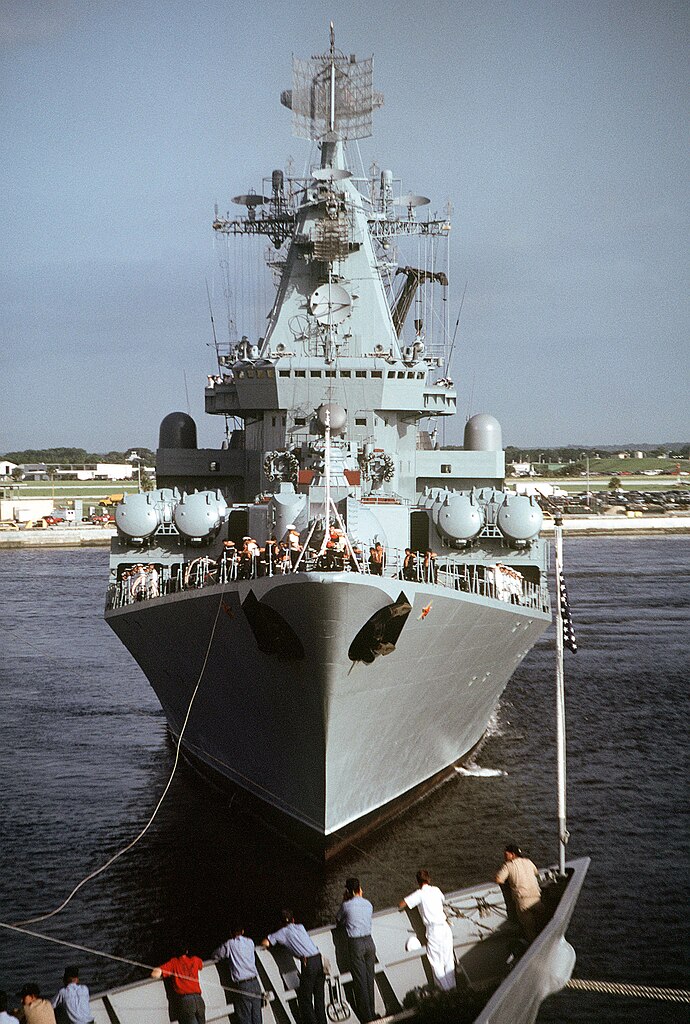
The deadline for completing repairs was postponed, by December 1, 2014, sea trials were announced for 2015 but by December that year, it was reported to be July 2016 and ultimately announced for the fall of 2016. In reality yard trials only took place from October 30 to November 30 that year and on December 24, she left for Severomorsk for final state trials and acceptance refresher cruise completed by April 2017.
On May 12, 2017, she had her cruise missilesloaded for exercises in the Barents Sea and by July 4, she trained with the cruiser “Vice Admiral Kulakov”, from Severomorsk to the Baltic. By the 29th, she takes part in the annual naval parade in St. Petersburg for the birth of the Navy and by December 5,completed all her combat training program Barents Sea, with scenarios in which she repelled a simulated air attack by Su-33 fighters.
Her later deployment was a the massive Joint exercises between the Northern and Black Sea fleets on January 9, 2020, witnessed by Russian President Vladimir Putin aboard Marshal Ustinov in the Black Sea. The cruiser fired her Kalibr cruise missiles and brand new Kinzhal from July 5 to November 23, 2018. She became flagship of the Parade in Kronstadt, and took part in all inter-naval exercises between the Baltic and Mediterranean; stopping en route to Algeria, Limassol in Cyprus and Ceuta in Spain. Medit. exercises were performed from August 11 to November 12, performing a number of ASW/AAW exercises, providing also assistance to a distress call.
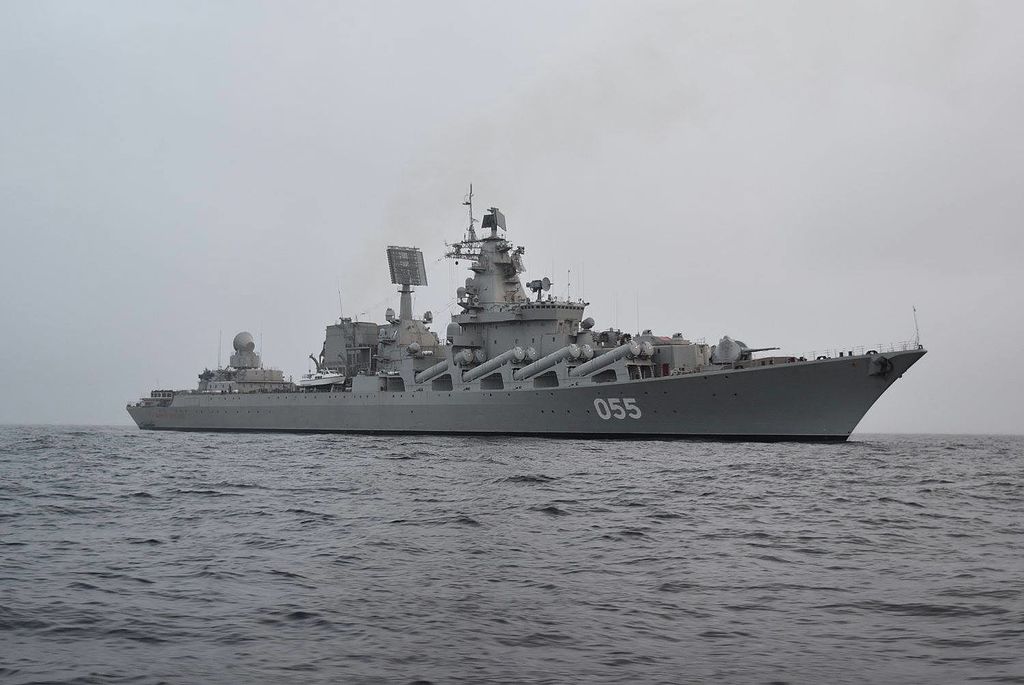
From July 3, 2019 to February 8, 2020, she complete her long cruise with a July 3, departure of Severomorsk for the St. Petersburg parade, followed by the exercise “Ocean Shield 2019” and returning to the Mediterranean by August 22, until October 26, 2019, patrolling the contested fishing area of Western Sahara-Mauritania. On January 9, 2020, she takes part in a joint military exercise between the Northern and Black Sea fleets again in the Black Sea with President Putin aboard again. She would cover 42,000 miles (77,000 kilometers) at this occasion, topping also in Equatorial Guinea and South Africa. By February 2021, she left Severomorsk for Barents Sea artillery drills, and others.
As for 2024, her status right now is undergoing exercizes in the Mediterranean, she is ending her serie and closing on Gibraltar src. Her 38 years career is not going to end soon.
 Varyag (ex-Chervona Ukraina)
Varyag (ex-Chervona Ukraina)
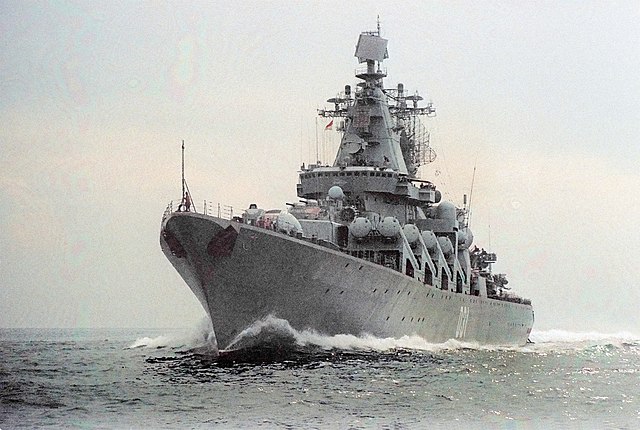
Varyag was formerly named Chervona Ukraina, as third of the Slava-class, she was laid down and built at 61 Kommunara Shipbuilding Plant (SY 445), Mykolaiv on 31 July 1979, launched on 28 August 1983 and Commissioned on 16 October 1989. Different from her two other sister ships, she is since the Flagship of the Pacific Fleet.
In 1990, at the head of a detachment she completed her weapons qualifications for service and inter-naval capabilities tests. From November 1990, she is the flagship of the Pacific Fleet, after being in 1996 renamed Varyag, and replacing Admiral Lazarev, assigned to the 36th division.
In 1997, she visited the South Korean port of Incheon, by 1999, she visited Shanghai for an official visit as part of the 50th anniversary of the founding of the PRC. In 2002, she was at the head of a detachment when visiting the Yokosuka for the 50th anniversary of the creation of the Japanese Maritime Self-Defense Force. In 2004, she visited Incheon again.
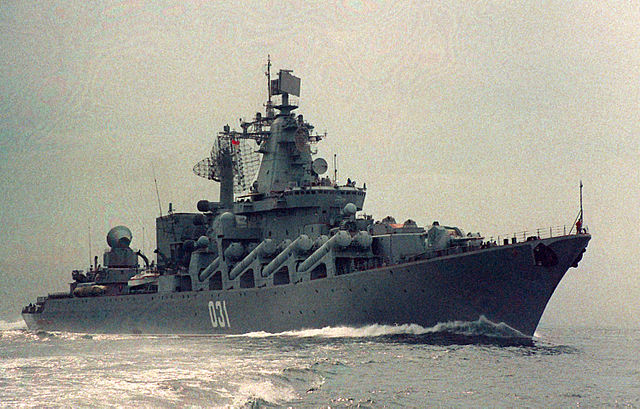
In September to December 2005, again leading a detachment she took part in majot fleet drills and manoeuvers in the Indian and Pacific oceans, calling Visakhapatnam in India, Tanjung Priok in Indonesia, Sattahip in Thailand, Changi in Singapore and Danang in Vietnam. From 2006 to 2008, she underwent a major overhaul at Dalzavod notably concerning her troublesome power plant. This was followed by sea trials and a refrsher cruise. In October 2008, she made an unofficial visit to Pusan. In 2009, she visited Qingdao.
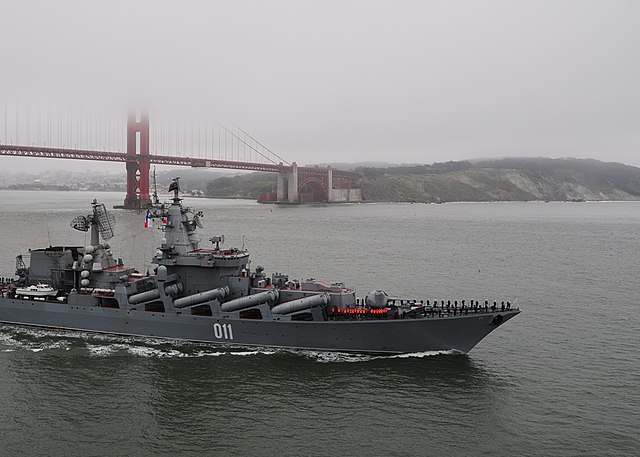
In June 2010, she made her first West Coat visit of the US with a visit of San Francisco. On November 9, 2010, she visited Incheon and took part aboard some artefacts and relics of the previous Russian cruiser Varyag and carrying President Dmitry Medvedev to the G20 summit in Seoul, November 10-12.
In April-May 2011, she took part in her first Sino-Russian exercize “Peace Mission 2011” in the Yellow Sea, stopping at Qingdao. In September-December 2011, she led a detachment for a major fleet exercize in the Pacific, stopping at Maizuru in Japan, Apra in Guam Island, and Vancouver in Canada after pushing along the Aleutians.
From April 23 to April 27, 2012, she sailed with Admiral Vinogradov, Marshal Shaposhnikov, Admiral Tributs and supply ships for another major Russian-Chinese exercise in the Yellow Sea.
By 2013, she underwent a new overhaul at Dalzavod and from July 5 to July 12, took part again in the joint exercize “Peace Mission 2013” in the Sea of Japan. July 13-20 escorted by the destroyer “Bystry”, cruiser “Admiral Vinogradov” and “Marshal Shaposhnikov”, the landing ships “Nikolai Vilkov” and “Oslyabya” she took part in mock landings exercises in the Central and Eastern Military Districts. At the end of August at the head of the whole Pacific Fleet, she made a trip acros the Indian Ocean, suez, and into the Mediterranean Sea, for an inter-naval cooperation with the “Peter the Great” from the Black Sea Fleet. On her way she topped at Trincomalee in Sri Lanka, Salalah in Oman and Alexandria in Egypt.
On May 20-26, 2014, she made another sortie with Bystry, Admiral Nevelskoy in the joint amphibious assault exercise “Maritime Interaction – 2014” with the PLAN. Both navies conducted similar operations and joint actions to defend ships at anchorage, release merchant ships captured by pirates and providing joint air defense, as well as ASW and SAR operations, plus live firing at sea and coastal targets. This was the most complex joint exercises ever done by both navies.
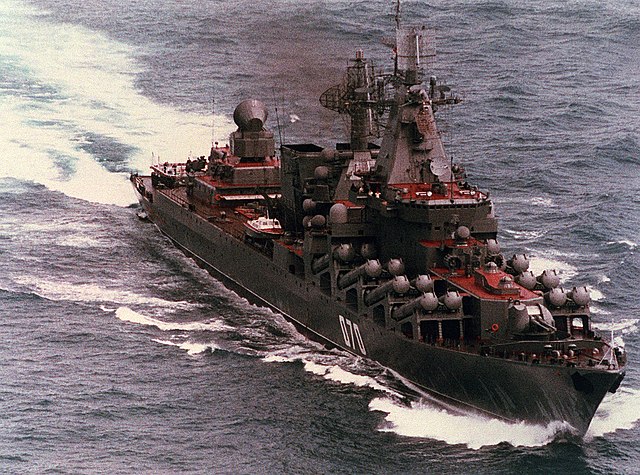
During these exercises, the Russian squadron visited Shanghai and on July 15-19, the squadron went on to participate in the scheduled Russian-Indian exercise “Indra-2014” in the Sea of Japan. Both practiced night combat and simulated search and destroyer operations of a submarine, as well as artillery drills on parachute and naval targets, and distress exercises. In September, she took part in the all-Russian exercise Vostok-2014. In November 2014, before the Australian G20 summit she led to detachments from the Pacific Fleet, and their presence caused a public outcry in Australia. From October 23 to December 15, 2014, she escorted Marshal Shaposhnikov, tanker Boris Butoma and rescue tug Fotiy Krylov for a long cruise in the southwestern Pacific.
On April 27, 2015, she was drydocked for maintenance at Dalzavod. December 7-12, 2015, saw her in a joint Russian-Indian naval exercise, Indra 2015, to the conclision of which she sailed to friendly Syria, reinforcing the Mediterranean squadron present for “counter-terrorist” operations. By December 29, 2015, Varyag is awarded the Order of Nakhimov, placed on the cruiser’s banner by Russian President Vladimir Putin on February 23, 2018 and on the 27th she had the Guards Order of the Naval Flag raised.
On January 3, 2016, she made another cruise in the Mediterranean, relieving Moskva near the coast of Syria and she provided combat cover for Russian Aerospace Forces air group and in complement of the installed S-300F air defense system at Khmeimim airfield. On July 18, 2016, she returned to Vladivostok.
On February 7, 2017, she is out for missile/gunnery drills, live firing exercises and from April 1 to June 14, 2017, she made a Pacific tour. She calls the port of Busan on April 11, Manila, (she hosts Philippine President Rodrigo Duterte), and covers 11,000 miles, before returning to Vladivostok on June 14. On October 9, in the Sea of Okhotsk, she takes part in a joint command and staff training with the SSN K-150 Tomsk firing a Basalt cruise missile at her as mock target.
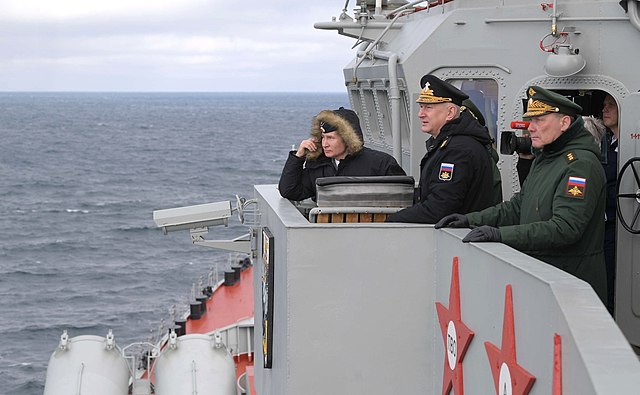
In 2017, she won the crew challenge prize of the Navy CiC, equivalent to the USN “E” for missile proficiency.
From October 1, 2018 to January 24, 2019, she leds a detachment for anotehr long-distance cruise in Asia, visiting nine countries along the way: Hakodate in Japan, Jeju in Korea, Qingdao in China, Tanjungpriok in Indonesia, Muara in Brunei), Changi in Singapore, Visakhapatnam in India, Colombo in Sri Lanka and Manila in the Philippines.
In August 2020, she taked par tin Ocean Shield 2020 with the cruiser K-186 Omsk, performing joint missile strikes in the Bering Sea. Varyag hit the target with a P-1000 “Vulcan” missile at 450 kilometers.
On 23 November 2021, she had an overhaul at Dalzavod, in dry dock.
On 29 December 2021, she sailed with DD Admiral Tributs and tanker Boris Butoma, from Vladivostok for for another long asian cruise, making port calls in several countries. On 11 January 2022, she taked part in joint exercises in the Indian Ocean, stopping at at Kochi on 14 January 2022. On 18 January 2022, she stopped at Chabahar, for joint exercises with the Iranian and Chinese navies. She entered the Mediterranean via Suez Canal, linked-up with sister ship Marshal Ustinov for joint drills and by July 2022, with Admiral Tributs and Intel ship Vasily Tatishchev they were the first Russian vessels in the Adriatic Sea since 1995 Volk’s deployment at the height of the war in Bosnia and Herzegovina. By late July, she is seen off Šibenik before detached for Durres, and the frigate Admiral Grigorovich waiting off Otranto. The US carrier Truman was also there, so some analysts saw this as a simulating blocking the carrier in the Adriatic.
By October 2022, Varyag, Admiral Tributs and Boris Butoma reutnrned to the Pacific, arriving on 18 November at Vladivostok.
Current status: Unkown.
 Ukraina (ex-Komsomolets, ex-Admiral Flota Lobov)
Ukraina (ex-Komsomolets, ex-Admiral Flota Lobov)
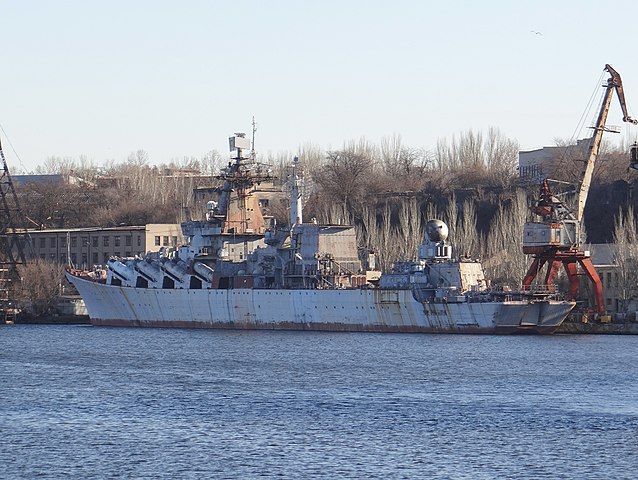
Ukraina was originally ordered by the Soviet Union in the early 1980s as “Admiral Flota Lobov” but after the fall of the early 1990s, she was passed on to Ukraine, and named after the country. However if she was launched in 1990, she is from there, docked unfinished in Mykolaiv to this day. The issues were that completion required many components built in Russia, and between bad will and budget constraints, she was never completed. So much so that in 2010 the Ukrainian parliament stripped the ship of her name and she remained as the unnamed “big rusty grey thing” currently moored at the Mykolayiv Shipyard (former 61 Kommunara Shipbuilding Plant) today.
Read More/Src

Books
Joshua Handler and William M. Arkin Greenpeace 1990
Pavlov A. S. Killers of aircraft carriers. Yakutsk: Lithograph, 2008. P. 4.
Links
Rendition by HI Sutton
web.archive.org web.ukonline.co.uk/ /slava/index.html
ru.wikipedia.org
web.archive.org fas.org 1164.htm
https://web.archive.org/web/20021202112154/http://www.warships1.com/RUSrkr06_Moskva.htm
http://www.periscope.ucg.com/weapons/ships/cruisers/w0003971.html
https://web.archive.org/web/20071221184534/http://www.hazegray.org/worldnav/russia/surface.htm
https://web.archive.org/web/20071214124444/http://www.fas.org/nuke/guide/nep5text.htm
https://web.archive.org/web/20070703191052/http://home19.inet.tele.dk/airwing/ships/moskva.htm
https://web.archive.org/web/20071022093707/http://www.cruiser-moskva.info/eng/photos/
https://web.archive.org/web/20150403131051/http://en.rian.ru/images/16555/41/165554149.jpg
https://commons.wikimedia.org/wiki/Category:Slava_class_cruisers
http://www.ww2.dk/new/navy/slava.htm
https://flot.com/nowadays/strength/surfaceships/#6
https://web.archive.org/web/20170705212103/army.lv/ru/proekt-1164/1142/365
https://www.rusarmy.com/vmf/rkr_pr_1164.htm
https://web.archive.org/web/20081015214537/http://www.navycollection.narod.ru/ships/Russia/Cruisers/RKR_Proect_1164/history3.html
https://structure.mil.ru/structure/forces/type/navy/pacific/flagship.htm
https://en.topwar.ru/227494-nerealizovannye-proekty-vmf-sssr.html
https://www.valka.cz/CG-Projekt-1164-Atlant-kod-NATO-Slava-t8776
https://russianships.info/eng/warships/project_1164.htm
http://www.navypedia.org/ships/ukraine/ukr_cr_ukraina.htm
http://www.navypedia.org/ships/russia/ru_cr_slava.htm
https://www.militarytoday.com/navy/slava_class.htm
Videos
See also this
See also by Dr. Alex Clarke
Model Kits
3D
Note: First published on Nov 8, 2017




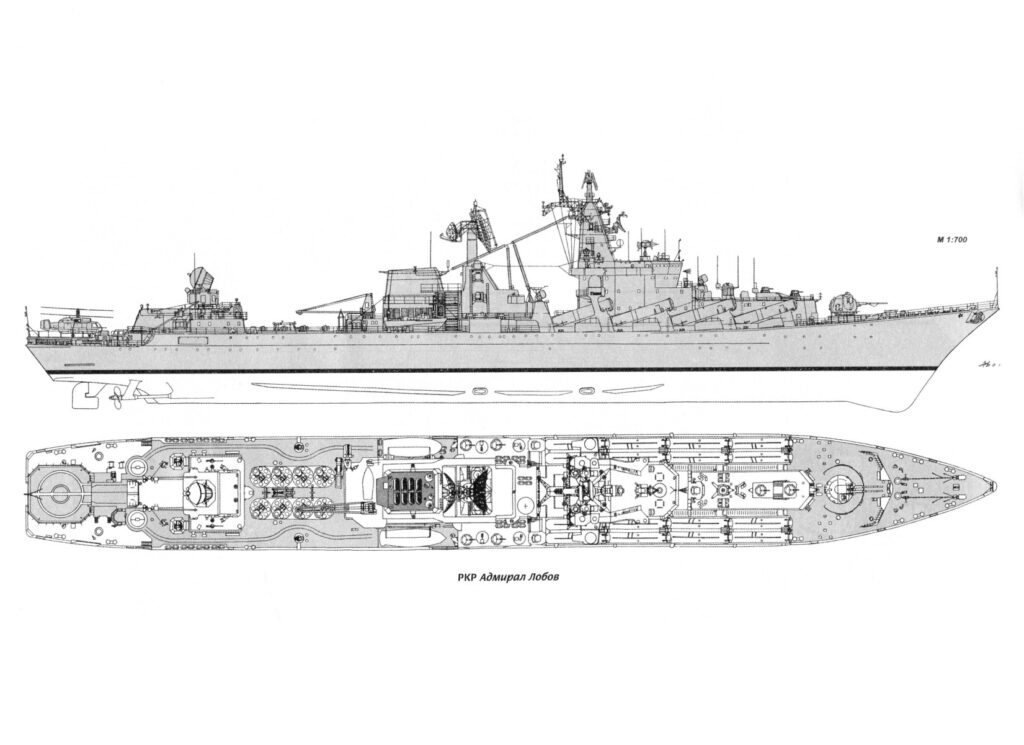
 Latest Facebook Entry -
Latest Facebook Entry -  X(Tweeter) Naval Encyclopedia's deck archive
X(Tweeter) Naval Encyclopedia's deck archive Instagram (@navalencyc)
Instagram (@navalencyc)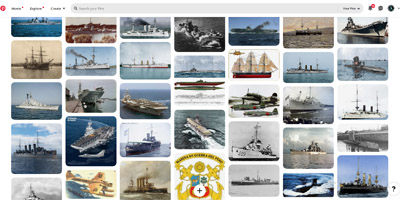


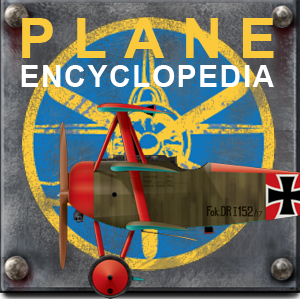
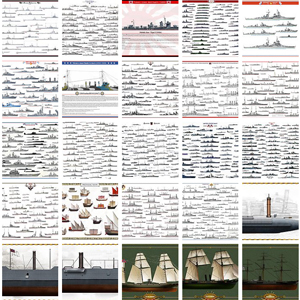
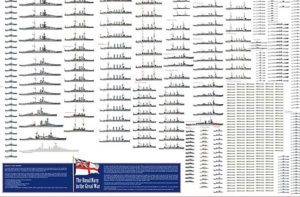
 French Navy
French Navy Royal Navy
Royal Navy Russian Navy
Russian Navy Armada Espanola
Armada Espanola Austrian Navy
Austrian Navy K.u.K. Kriegsmarine
K.u.K. Kriegsmarine Dansk Marine
Dansk Marine Nautiko Hellenon
Nautiko Hellenon Koninklije Marine 1870
Koninklije Marine 1870 Marinha do Brasil
Marinha do Brasil Osmanlı Donanması
Osmanlı Donanması Marina Do Peru
Marina Do Peru Marinha do Portugal
Marinha do Portugal Regia Marina 1870
Regia Marina 1870 Nihhon Kaigun 1870
Nihhon Kaigun 1870 Preußische Marine 1870
Preußische Marine 1870 Russkiy Flot 1870
Russkiy Flot 1870 Svenska marinen
Svenska marinen Søværnet
Søværnet Union Navy
Union Navy Confederate Navy
Confederate Navy Armada de Argentina
Armada de Argentina Imperial Chinese Navy
Imperial Chinese Navy Marinha do Portugal
Marinha do Portugal Mexico
Mexico Kaiserliche Marine
Kaiserliche Marine 1898 US Navy
1898 US Navy Sovietskiy Flot
Sovietskiy Flot Royal Canadian Navy
Royal Canadian Navy Royal Australian Navy
Royal Australian Navy RNZN Fleet
RNZN Fleet Chinese Navy 1937
Chinese Navy 1937 Kriegsmarine
Kriegsmarine Chilean Navy
Chilean Navy Danish Navy
Danish Navy Finnish Navy
Finnish Navy Hellenic Navy
Hellenic Navy Polish Navy
Polish Navy Romanian Navy
Romanian Navy Turkish Navy
Turkish Navy Royal Yugoslav Navy
Royal Yugoslav Navy Royal Thai Navy
Royal Thai Navy Minor Navies
Minor Navies Albania
Albania Austria
Austria Belgium
Belgium Columbia
Columbia Costa Rica
Costa Rica Cuba
Cuba Czechoslovakia
Czechoslovakia Dominican Republic
Dominican Republic Haiti
Haiti Hungary
Hungary Honduras
Honduras Estonia
Estonia Iceland
Iceland Eire
Eire Equador
Equador Iran
Iran Iraq
Iraq Latvia
Latvia Liberia
Liberia Lithuania
Lithuania Mandchukuo
Mandchukuo Morocco
Morocco Nicaragua
Nicaragua Persia
Persia San Salvador
San Salvador Sarawak
Sarawak Uruguay
Uruguay Venezuela
Venezuela Zanzibar
Zanzibar Warsaw Pact Navies
Warsaw Pact Navies Bulgaria
Bulgaria Hungary
Hungary

 Bundesmarine
Bundesmarine Dutch Navy
Dutch Navy Hellenic Navy
Hellenic Navy Marina Militare
Marina Militare Yugoslav Navy
Yugoslav Navy Chinese Navy
Chinese Navy Indian Navy
Indian Navy Indonesian Navy
Indonesian Navy JMSDF
JMSDF North Korean Navy
North Korean Navy Pakistani Navy
Pakistani Navy Philippines Navy
Philippines Navy ROKN
ROKN Rep. of Singapore Navy
Rep. of Singapore Navy Taiwanese Navy
Taiwanese Navy IDF Navy
IDF Navy Saudi Navy
Saudi Navy Royal New Zealand Navy
Royal New Zealand Navy Egyptian Navy
Egyptian Navy South African Navy
South African Navy






























 Ukrainian Navy
Ukrainian Navy dbodesign
dbodesign